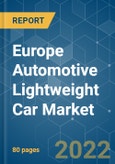The Europe lightweight car market is expected to register a CAGR of about 9.7% during the forecast period (2020 - 2025).
Key Highlights
- Currently, the market for lightweight vehicles is primarily driven by regulatory authorities pushing for fuel-efficiency and increased demand from the developed economies of Europe for higher focus on reducing the cost of materials through consistent research drive the growth of the lightweight car market.
- The ideal materials for lightweight cars in this market include aluminum, high strength steel, and magnesium. With the enactment of stringent emission norms and fuel economy standards in the European region, the region's automobile manufacturers have started using carbon fiber composites in the manufacturing of their vehicles.
- With the emergence of electric vehicles and an increasing ban on diesel vehicles' production of gasoline and diesel engines, the fossil fuel-run automotive industry's growth may face negative growth. However, lightweight car materials will remain a driving factor due to its application in an alternative fuel vehicle market.
Key Market Trends
Continuous Evolution in automotive AHSS technology
There is a demand for reducing the weight to enhance vehicle performance and safety. As a result, Advanced High Strength Steel (AHSS), an essential material for mass vehicle reduction, and has become one of the fastest-growing material in today's automotive industry.
Steel makes up around 70 % of an average automobile's weight. Compared to standard steel, AHSS enable to reduce vehicle weight by 23-35% which is around 165 to 250 kg, for a regular passenger car, saving 3 - 4.5 tons of greenhouse gases over the vehicle's total life cycle. This saving in emissions is much more substantial than the CO2 emitted during the complete production of steel needed in a car.
The steel composition involves 34% as the body structure, panels, doors, and trunk closures, giving it an energy absorption and high-strength in case of a crash. 23% is the engine and machinable carbon steel for the wear-resistant gears. 12% is used in the suspension, using rolled high-strength steel and the remainder in the wheels, tires, fuel tank, steering, and braking systems.
To produce higher strength for reduced steel section size and weight, automakers use less material, significantly reducing a vehicle's weight. The steel industry is focusing on developing different alloys for processing combinations, steel with high tensile strength and ductility, along with optimizes chemical compositions to achieve multiphase microstructures of AHSS.
Other advancements include the expanded capabilities to automotive steels that have high strength, which enable the design of thinner parts optimizing stiffness but maintaining geometries. AHSS such as Nano Steel helps deliver thinner gauges of steel and components to manufacture at room temperature.
In 2018, the technical partnership between Aston Martin and Dow has enabled the development towards AHSS and implementation of customized industry-leading solutions in light-weighting, powertrain efficiency, and vehicle electrification.
Germany will lead the European lightweight car industry.
In 2016, 195 parties within the United Nations Framework Convention on Climate Change signed the Paris Agreement deal to extend its ongoing efforts. The primary idea is to keep the global temperature increase below 2°C and within. In 2017, the Europe record greenhouse gas emissions of 4.5 Gt CO2 eq. As a result, the EU became the main of the significant contributors to GHGs.
Many German companies are experimenting with new composites that can reduce the vehicle's total weight to a great extent. The application of carbon-fiber-reinforced plastic (CFRP) has been widely adopted to produce automotive bodies, particularly in German manufactured cars, such as BMW and Audi.
Germany is also one of the largest manufacturers of lightweight vehicles. With the market for lightweight vehicles in development, various initiatives within Germany are driving the technological advancements. As per, regulatory framework (Euro 6 norms), there is a growing motivation for a low-carbon economy by 2050.
Research organizations such as the Affordable Lightweight Automobiles Alliance(AFLA) are specialized to deal with automotive light-weighting, which is co-funded by the European Commission's Horizon 2020 and EUCAR, the European Council for Automotive R&D. European carmakers such as Daimler, Volkswagen, Fiat-Chrysler Research Centre, Volvo, Opel, and Toyota are working together to produce more efficient vehicles. Their goal is to reduce energy consumption by 10% and global warming potential (GWP) by 6% by reducing the vehicle's weight by 31 to 33% while maintaining the cost.
Competitive Landscape
The Europe lightweight car market is moderately consolidated with existing players such as ThyssenKrupp AG, SSAB AB, POSCO, ArcelorMittal SA, Baoshan Iron & Steel Co. Ltd., AK Steel Holding Corporation. As the demand for the lightweight car is growing in the region, the automotive manufacturers are trying to edge over its competitors by making joint-ventures, partnerships, and launching new products with advanced technology.
For instance, BMW partnered with German carbon fiber producer SGL Group and spent ~USD 1 billion for securing the supply chain for CFRP used in the production of i3 and i8. Apart from BMW, another German automobile manufacturer Audi has also been using CFRP to produce the space frame's rear wall for its A8 luxury sedan. This part provides ~40% of the vehicle's overall torsional rigidity, making it a suitable material for the usage in the car. The part is ~50% lighter in weight than its metallic predecessor.
Additional Benefits:
- The market estimate (ME) sheet in Excel format
- 3 months of analyst support
This product will be delivered within 2 business days.
Table of Contents
Methodology

LOADING...








